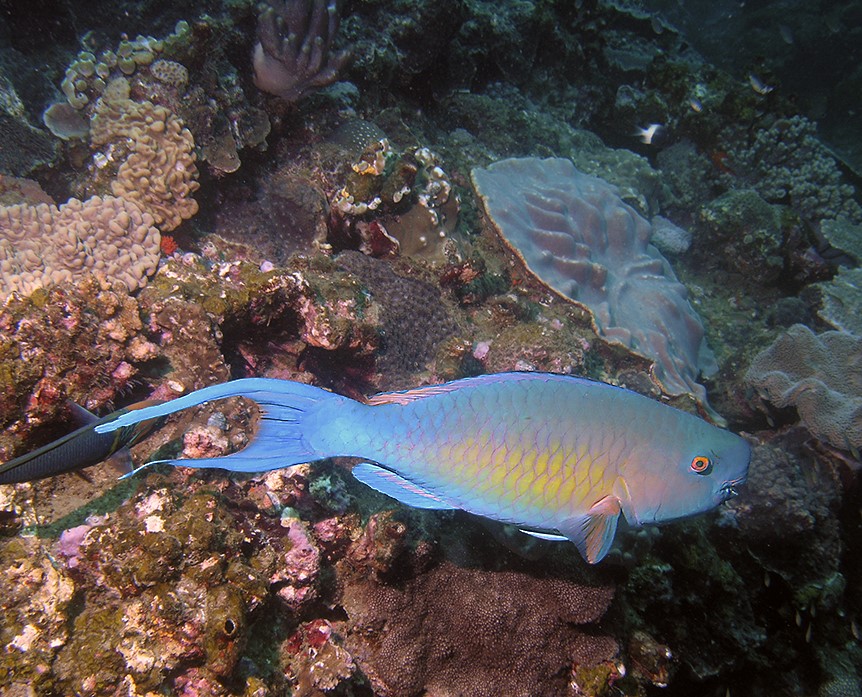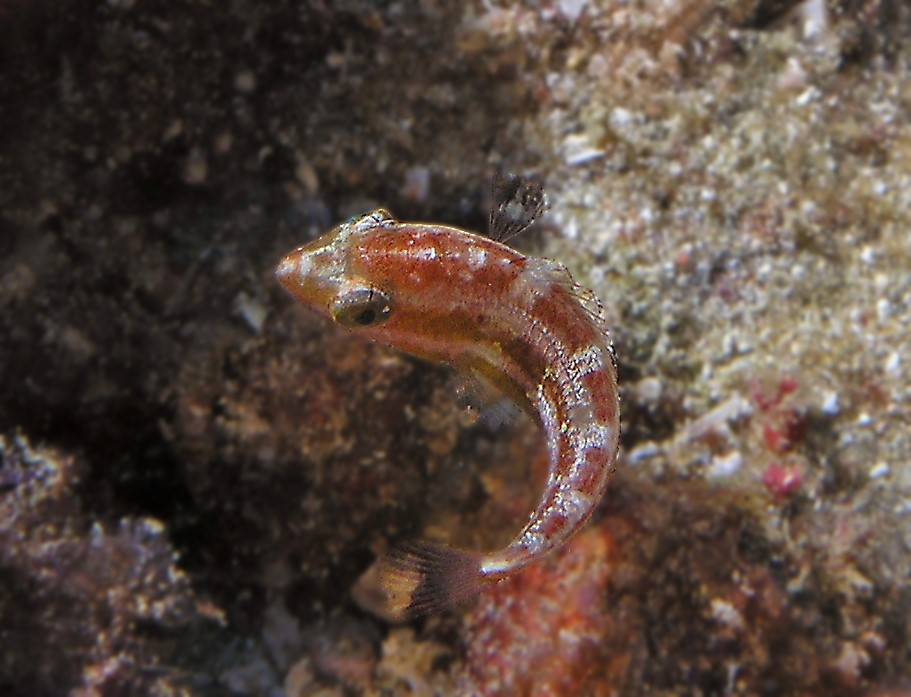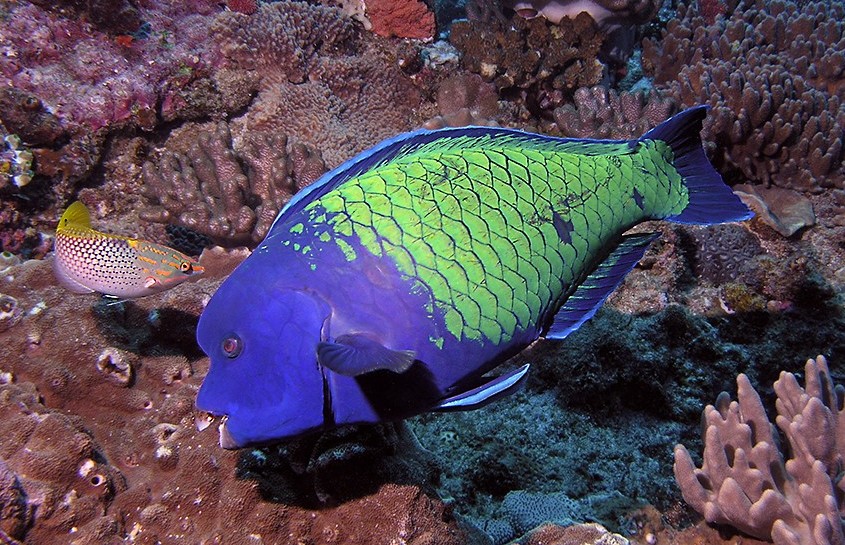News
Diving the Indian Ocean Reefs

Parrot Fish… Did You Know?
The most colourful fish you’ll notice at on your first Indian Ocean dive may well be the spectacular turquoise-green, blue and pink male Ember Parrot Fish, (Scarus Riboviolaceus) which is by far the most common of the parrot fishes seen on our Indian Ocean reefs.

Male Ember Parrot fish
The males are gorgeous, and completely different from the juveniles and females.
Parrot fishes start life in the hard stag-horn corals and branching finger corals as insignificant little striped fish. The juvenile and semi-juvenile just look like any other small striped fish, with only the distinctive beak-like mouth to distinguish them from any other very young fish species.

Semi-Juvenile Ember Parrot Fish
They grow into nondescript rust grey and brown females who inconspicuously cruise across the reef crunching on the hard corals. As young fish they travel in groups, but as they get older and bigger, they feed alone.

Juvenile Ember Parrot Fish
As they grow their colouring develops, and they become more spectacular, with bigger bodies, richer fin outlines and the drab brown begins to bloom with new colour. There can only be one male in any area. One day, when the dominant male in an area dies, the largest female loses her mind and her drab colouring and turns into a peacock-coloured randy male who chases the drab brown females across the reef, mating indiscriminately.
As the male reaches terminal stage, his colouring begins to fade and he dies. We have seen huge terminal male Ember Parrot Fish in the sea-grass beds South of Stringer Reef at Sodwana Bay.

On the shallower reefs, you may be lucky enough to see the rare and beautiful Bridle Parrot (Scarus Frenatus) fish, and if you look carefully at the markings, you may be able to distinguish a Tricolour Parrot ( Scarus Tricolor) fish from a Christmas or Starry-Eyed (Calotomus carolinus) parrot fish, or spot an occasional Blue Moon Parrot ( Chlorurus Atrirunula) fish.

We have seen Blue Barred Parrot ( Scarus Ghobban) fish, and in deeper water, around and occasionally on the staghorn corals on the edge of 2 Mile Sodwana Bay, you might be lucky enough to see the richly coloured dark blue velvet of a female Hump Head Parrot ( Chlorurus Cyanascens) fish, or the ornate green and blue of the male Hump Head.

The Parrot fish family lives on the polyps and algae that make up the hard corals, and they graze continually. Living on hard corals is enormously time consuming, as the nutritious part of the polyp is minute. The parrot fishes are at least partly responsible for containing the growth of finger corals and branching corals.
They excrete a fine white powder which in part makes up most of the world’s powder white coral sand beaches – bio-sand production perhaps?
In Mauritius parrot fish are a delicacy, and the result has been a massive depletion in the variety of species near the main Island.
Under-age sex is the norm among the parrot fish here, with very juvenile females taking on the male role when they are too young. They are breeding a dwarf ember parrot fish, which has become quite prolific as it is too small to eat. I have often seen 8 inch little ember males haring after distinctly under-age females with lustful eyes.
On the outer Islands, the parrot fishes grow to normal size, as the subsistence fishermen cannot take their little boats out to the distant Islands. As the numbers of subsistence fishermen drops with the increase of wealth among the Mauritian population on the Island, perhaps we’ll see the exquisite parrot fish replaced on local menus by chicken.
[hr style=”single”]
Words Jill Holloway
Pics David Holloway
Copyright Ocean Spirit
Gear News
Introducing the TR-80, IR-50 and CS-30 Regulators from DYNAMICNORD

Whether you are a beginner or a professional diver – with the three new main regulators from DYNAMICNORD, everyone will find their favourite regulator. They all look super stylish.
Excellent performance with the TR-80
Quality and performance are the be-all and end-all for regulators. It is not for nothing that the TR stands for Tec Reg. The innovative design of the TR-80 guarantees absolute reliability – even in ice-cold waters.

Perfect breathing effort at 0.8 J/l / certified for diving in waters below 10 degrees / structural design made of solid brass for best cold protection / membrane-compensated design with dry seal of the first stage / reduced exhalation effort thanks to optimized exhalation membrane and bubble deflector / adjustable Venturi (dive/predive) and adjustment knob for individual inhalation comfort / innovative design of the front cover prevents free-flow in strong currents or when diving with scooters / design made of sandblasted brass, matt chrome finish / 2 HP and 4 LP outlets / mouthpiece made of high-quality, anti-allergic silicone for maximum comfort.


Amazing underwater adventures with the IR-50
The IR-50 is the top regulator for advanced and experienced divers. Natural breathing is the essence of this regulator.

Ideal breathing effort at 0.8 J/l /certified for diving in waters below 10 degrees / compensated membrane / adjustable venturi (dive/predive) and adjustment knob for individual inhalation comfort/ outlet valve and deflector for minimum exhalation effort and reduction of bubbles on the face / design made of sandblasted brass, matt chrome finish / 2 HP and 4 NP outlets / mouthpiece made of high-quality, anti-allergic silicone for maximum comfort.


The Workhorse – our CS-30
For diving centres and diving beginners – the workhorse stands for strong construction, reliability and robustness. Perfect for your training.

Optimal breathing effort at 0.8 J/l /recommended for diving in waters above 10 degrees / non-compensated piston / adjustable venturi (dive/predive) / outlet valve and deflector for minimum exhalation effort and reduction of bubbles on the face / design made of sandblasted brass, matt chrome finish / 1 HP and 3 NP outlets / mouthpiece made of high-quality, anti-allergic silicone for maximum comfort.


Octopus OP-30
The OP-30 is the ideal addition to all DYNAMICNORD regulators. It is identical in construction to the CS-30.

The TR-80, IR-50, CS-30 (DIN & INT) regulators and the Octopus OP-30 are available from DYNAMICNORD dealers and in the online store.
DYNAMICNORD – Your Outdoor Companion.
Marine Life & Conservation
Paul Watson Released as Denmark Blocks Japan’s Extradition Bid

Renowned anti-whaling activist Paul Watson has been released from custody in Greenland after spending five months in detention. Denmark’s Justice Ministry rejected Japan’s request for his extradition, citing insufficient guarantees that his time already served in custody would be credited against any potential sentence.
The 74-year-old Canadian-American was arrested on July 21 in Nuuk, Greenland’s capital, when his ship docked to refuel. His arrest was based on a 2012 Japanese warrant related to a 2010 encounter in Antarctic waters. Japan alleged Watson obstructed operations and caused damage to a whaling research ship during efforts to disrupt illegal whaling. Watson has consistently denied these claims, maintaining his commitment to marine conservation.
Denmark, which oversees extradition matters for Greenland, concluded that while the legal conditions for extradition were met, the lack of assurances from Japan regarding time-served credit made extradition untenable.
In a video shared by his foundation, Watson expressed gratitude and relief, saying, “After five months, it’s good to be out… and good to know they’re not sending me to Japan.” He added that the most difficult part of his time in custody was being separated from his two young sons.
Watson is a pioneering figure in marine conservation, known for founding the Captain Paul Watson Foundation in 2022 after decades of activism with the Sea Shepherd Conservation Society. His bold efforts to defend marine life have earned him widespread support, including from celebrities and conservationists. His work has also been featured in the acclaimed reality TV series Whale Wars.
Watson’s lawyer, Jonas Christoffersen, praised the decision, stating, “We are happy and relieved that Paul Watson is now free.” He added that Watson is eager to reunite with his family and continue his vital work.
The arrest occurred while Watson’s vessel, the M/Y John Paul DeJoria, was en route to the North Pacific with a team of 26 volunteers to intercept a Japanese whaling ship. His foundation described the arrest as politically motivated and emphasized that Watson’s actions were focused on ending illegal whaling practices.
Japan resumed commercial whaling in 2019 after leaving the International Whaling Commission, asserting that whale meat is a cultural tradition. Conservationists, however, continue to challenge these practices, highlighting their impact on marine ecosystems.
Despite the challenges, Watson remains steadfast in his mission to protect marine life and bring attention to whaling practices. His dedication to ocean conservation has made him a globally respected advocate for the environment.
-

 News2 months ago
News2 months agoIconic SS United States to become the World’s Largest Artificial Reef
-

 News3 months ago
News3 months agoBook Review – 52 Assignments: Underwater Photography
-

 Gear News3 months ago
Gear News3 months agoDYNAMICNORD – New German diving brand enters the British market
-

 News3 months ago
News3 months agoExploring Cenote El Pit: A Diver’s Dream
-

 Gear News3 months ago
Gear News3 months agoTry BARE drysuits (and maybe even win one!) this Friday with Sea & Sea at North West Dive Fest
-

 Marine Life & Conservation3 months ago
Marine Life & Conservation3 months agoBook Review: Coral Triangle Cameos
-

 Blogs2 months ago
Blogs2 months agoDive the Egyptian Red Sea this Autumn with Regaldive
-

 News3 months ago
News3 months ago2024 Ocean Art Underwater Photo Competition Announced















